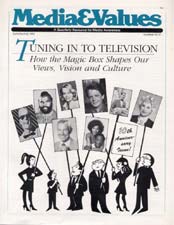Second Decade Marks Move to Wider Arena
|
This article originally appeared in Issue# 40-41
|
Fiber versus fat. Running hard versus standing still. Lean but not mean. Elizabeth Thoman, CHM, executive editor of Media&Values, is conscious of her diet, but when she uses nutrition-centered language, she's almost certainly using it as a metaphor for what goes into the mind. And she's doing her energetic best to help consumers around the world be as concerned about the media they watch, hear and think about as the food they eat.
"Who would have thought 20 years ago that we would be concerned about fiber and fats? I hope by the time Media&Values celebrates its twentieth anniversary people will be equally concerned about the quality and kinds of media in their lives."
If they're not it won't be Thoman's fault. The CHM sister started Media&Values 10 years ago while she was still earning her master's degree at the Annenberg School of Communications at the University of Southern California in Los Angeles. That was when VCRs and computer networks were still a gleam in futurists' eyes. Recognizing that new media technology would have an ever more profound effect on people's lives, thoughts and feelings, she decided to start a publication that could help religious, educational and community leaders recognize the social impact of new media and technology.
Few small magazines last until their tenth birthdays, and there were certainly times when Media&Values' survival appeared questionable. The greatest threat to its existence occurred in 1983, when its then-sponsoring organization. the Center for Communications Ministry (CCM), went out of business.
But the magazine — everything from the copyright to the paper clips — was purchased from CCM by the Media Action Research Center (MARC.) in cooperation with a dozen Protestant, Catholic and Jewish agencies. "It not only kept us going but enabled us to reach out to a wider and more varied audience," Thoman says.
According to Rosalind Silver, associate editor, who joined the CCM staff in 1983 and has participated in Media&Values' evolution from a 12-page newsletter to a growing magazine, this constant improvement typifies the spirit at Media&Values. "Details and revisions are crafted until we just have to go to the printer. We've never stood still, and I'm sure we never will. We try to improve with every issue."
During its reorganization, the new board of directors helped the staff target a wider readership of educators and religious leaders as well as communicators. They also developed an even more important philosophical change: the conscious incorporation of the methodology of Brazilian educator Paulo Freire. His four step blueprint for social change, first used in literacy work in South America, moves along a continuing upward spiral from awareness to analysis to reflection to action. The magazine's thematic approach now uses this continuum to move beyond outlining a media issue to suggesting actions that can bring about change.
As Media&Values moves into its second decade, its directors and staff are actively working to transform the magazine's consciousness-raising role into a movement. As it grows it will increasingly enable media consumers as well as producers to raise questions about and claim greater responsibility for the social impact of mass media and new technology in their lives. The plan is to develop workshops, conferences and media awareness resources such as video tapes to organize a membership constituency to 'raise the voice of values' in today's Media Age.
As Thoman points out, "Anyone who has been through any kind of consciousness-raising experience knows the transformative power of such a process. Certainly the civil rights movement, the peace movement, the feminist movement, as well as nutrition and fitness awareness, are all aspects of growing individual and planetary consciousness in our time."
In the meantime, as these plans mature, their fruition and the magazine's growth depend heavily on the success of ongoing fundraising efforts that support over half its budget and are essential for future development.
"Our circulation is growing, but anyone who knows anything about opinion magazines knows they are almost never self-supporting." Thoman says. Since Media&Values accepts no advertising, its whole income depends on subscriptions and outside support.
Perhaps because Thoman's enthusiasm is infectious, the magazine — and now the movement — has been blessed by volunteers and supporters who recognize that it is something unique.
As it continues its challenging transition into a wider arena, everyone at Media&Values will continue to adhere to their long-standing motto: "When it comes to the impact of media in our society there are no easy answers. What is more important is learning to ask the right questions.



